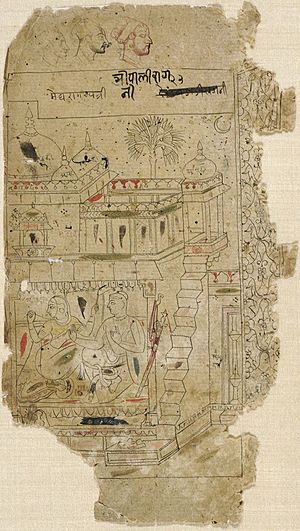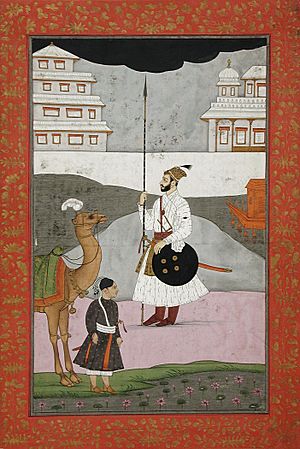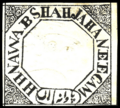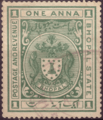Nawabs of Bhopal facts for kids
Quick facts for kids Nawab of Bhopal |
|||||||||||||||||||
|---|---|---|---|---|---|---|---|---|---|---|---|---|---|---|---|---|---|---|---|

Coat of arms of Bhopal
|
|||||||||||||||||||
| Creation date | 1707 | ||||||||||||||||||
| First holder | Dost Mohammad Khan (1707–1728) | ||||||||||||||||||
| Last holder | Hamidullah Khan (1926–1949) | ||||||||||||||||||
| Status | Title abolished | ||||||||||||||||||
| Extinction date | 1 June 1949 | ||||||||||||||||||
|
|||||||||||||||||||
The Nawabs of Bhopal were powerful Muslim rulers in Bhopal, a region that is now part of Madhya Pradesh, India. A "Nawab" was a royal title, similar to a prince or governor. These rulers led Bhopal for many years.
They ruled under different empires over time. From 1707 to 1737, they were part of the Mughal Empire. Then, from 1737 to 1818, they were under the Maratha Empire. After that, from 1818 to 1947, they ruled under British rule. Bhopal became independent after 1947. Finally, in 1949, Bhopal joined the country of India.
Interestingly, some of Bhopal's most famous rulers were women. They were called the Nawab Begums of Bhopal.
Contents
Leaders of Bhopal
This section lists the important rulers of Bhopal. They led the state through many changes.
Male Nawabs of Bhopal
- Dost Muhammad Khan (ruled 1707–1728): He was born around 1672. Dost Muhammad Khan founded the state of Bhopal in 1707. He also started the city of Islamnagar in the early 1720s.
- Sultan Muhammad (ruled 1728–1742): Born in 1720, he became Nawab after Dost Muhammad Khan.
- Yar Muhammad Khan (Regent 1728–1742): He helped rule Bhopal during this time.
- Faiz Mohammad Khan (ruled 1742–1777): Born in 1731, he took over the rule in 1742.
- Hayat Muhammad Khan (ruled 1777–1807): Born in 1736, he ruled for 30 years.
- Ghaus Muhammad Khan (ruled 1807–1826): Born in 1767, he was the Nawab for almost two decades.
- Muiz Muhammad Khan (ruled 1826–1837): Born around 1795, he ruled for 11 years.
- Jahangir Muhammad Khan (ruled 1837–1844): Born in 1816, he was Nawab for seven years.
Female Nawab Begums of Bhopal
Bhopal was unique because it had several powerful female rulers. They were called Nawab Begums.
- Qudsia Begum (ruled 1819–1837): In 1819, at just 18 years old, Qudsia Begum became the ruler. She was also known as Gohar Begum. She was the first female ruler of Bhopal. She decided that her two-year-old daughter, Sikander, would rule after her. No one in the family dared to challenge her choice. She ruled until 1837, making sure her daughter was ready to lead the state.
- Nawab Sikandar Begum (ruled 1860–1868): She followed her mother, Qudsia Begum. Sikandar Begum was a strong leader.
- Begum Sultan Shah Jehan (ruled 1844–1860 and 1868–1901): Shah Jehan was the only child of Sikandar Begum. She became ruler in 1844 when she was only six years old. Her mother, Sikandar Begum, acted as regent (a temporary ruler) while Shah Jehan was young. Later, her mother was recognized as the main ruler. During Shah Jehan's time, Bhopal started issuing its own postage stamps. These stamps had her name on them.
- Begum Kaikhusrau Jahan (ruled 1901–1926, died 1930): She ruled for 25 years. She later gave up her title to her son.
Titular Rulers
A "titular" ruler means someone who holds the title but no longer has real power.
- Nawab Sir Hafiz Muhammad Hamidullah Khan Bahadur (ruled 1926–1947, titular until 1960): He was the last Nawab with real power. After 1947, he was still called Nawab but did not govern. He passed away in 1960.
- Sajida Sultan, Begum of Bhopal (ruled 1960–1971): She was the titular Begum of Bhopal. In 1971, India removed all royal titles.
Images for kids
See also
- List of Sunni Muslim dynasties
- Pathans of Madhya Pradesh






